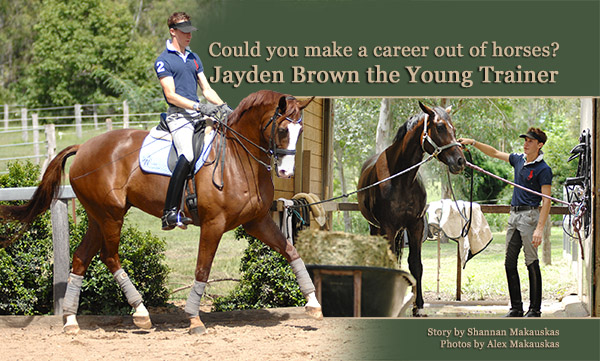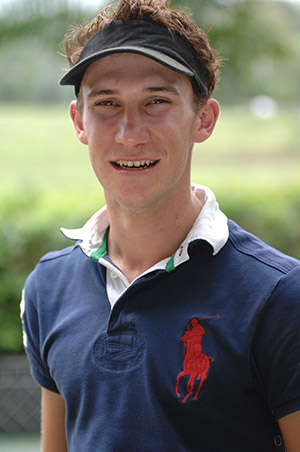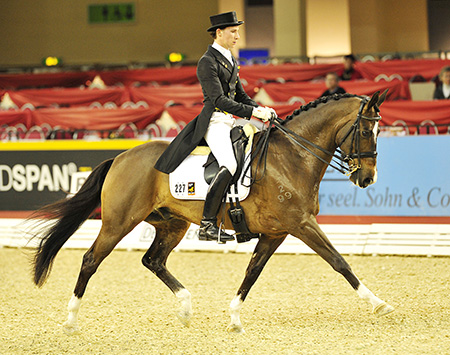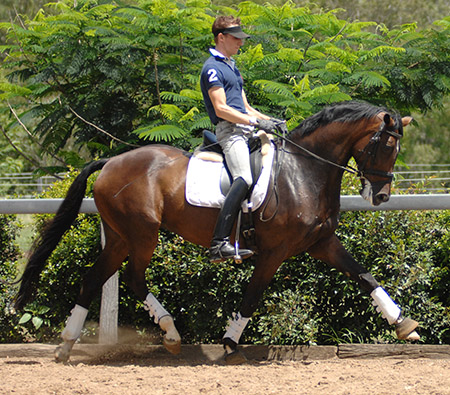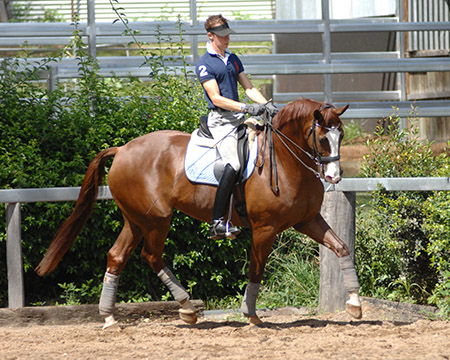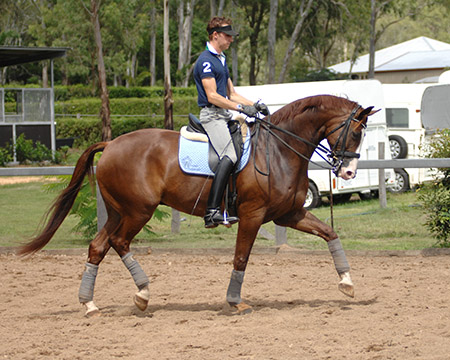Story by Shannan Makauskas Photos by Alex Makauskas
There comes a time in the young rider’s life when they contemplate going to university or pursuing a life long dream of being a horse trainer. For 21 year old dressage rider, Jayden Brown, the choice was easy: “It’s the only thing I can get people to pay me for,” he laughs.
But all jokes aside, Jayden has rapidly evolved from young rider to professional trainer. So how did he make the transition? I went to Jayden’s property on the outskirts of Brisbane in Queensland to find out.
Starting Out
Jayden began riding by chance at six years of age: “We inherited a feral old horse from our neighbour that became the family horse we all learnt to ride on.”
It wasn’t long until Jayden had a pony of his own: “He was a fat little Palomino called Willow. He was kind of like the pony in Brookfield that every family had owned. I remember he would take off for anyone taller than a kid, but for kids he was perfect. I did all the pony club gymkhanas and the Brookfield show was sort of my yearly hacking experience.”
At 12 years of age Jayden purchased his first horse, the five year old gelding Fairbanks Gangster. He remembers their first competition together: “It was a pony club combined training and I think we got 36% in the walk trot.”
“Then it was the only clear showjumping round we ever did. We came second but I came out of the arena crying and the judges told me he was too big for me and too much horse. Years later everyone was telling me to sell him because he was too small.”
Choosing a Path
After dabbling in every discipline, from Palomino classes to eventing, Jayden opted to focus on Dressage: “It wasn’t really until Fairbanks Gangster refused to go in the water that I waltzed into dressage. I think I was sick of coming last. The one eventing competition I finished was at the State Championships but then we were a minute too slow.”
I’m always surprised to find, when I ask a rider why they stick with a certain discipline, it provokes several minutes of deep thought and unresolved answers. It seems we don’t always know why we struggle through such a challenging and unrecognised sport, we just do it!
This was the case with Jayden but he concludes: “It’s just for the challenge and because you’re never perfect. In dressage you’ve always got to keep getting better or someone else will beat you.”
Finding a Mentor
When Fairbanks Gangster started elementary Jayden began lessons with Jenny Gherke, Grand Prix rider and member of the Australian Development Squad. He said of their early lessons together: “For the first month I didn’t leave walk. Jenny would say, ‘Walk. Halt. No, you’re pulling. Walk. Halt. No, you’re pulling.’”
“I had to do laps of the arena and stop at every single post until I could halt. Because I would pull my reins up to my ears to stop and he had one of those bungy rope necks that would just invert into his chest. She said, ‘I figured you would stick with it. You were either going to get better or you were going to leave’. So that’s how Jenny and I got started.”
Jayden recognises Jenny as the biggest influence on his dressage career: “She started as a coach and is now a mentor and a friend.”
The format of their lessons has progressed over the years: “We don’t do the set 45 minute lesson anymore. We just kind of ride together and help each other out and that really works.”
“We have a sit on each other’s horses a couple of times a week and fiddle around. Usually we just back up what we were both thinking anyway but having a different rider to challenge the horse in a different way helps to bump them along a bit. We don’t just end up riding circles for months and wondering why we’re not getting any better.”
Learning the Craft
In the school holidays Jayden worked at Jenny’s equestrian center: “I’d strap for her and help her get the horses ready. I would warm them up and she’d help me on lots of different horses.”
“She had an elementary horse and he was the first one I learnt how to stop properly on. She put him on the lunge and took the reins off. Then she’d put him into canter and say, ‘I’m just going to stand here until you figure out how to stop him without pulling.’”
“I would hold onto the little monkey strap and just by nature I wanted to pull. Obviously nothing happened until I figured out how to use my seat. He was well trained and as soon as I did it properly he just went canter, walk. And I said, ‘Oh so that’s what I’ve got to do. No more pulling.”
Over six years Jayden and Fairbanks Gangster won three National Young Rider Championships and several State Championships, eventually progressing to FEI level before being sold. The sale led Jayden to his first training stint in Germany with former Olympian, Leonie Bramall: “I first met Leonie when I went to Germany after grade 12 to be a working student. Jenny had previously trained with Leonie in Germany and she helped me to organise six weeks work.”
Since then Jayden has gone to Leonie’s to train three times: “Thinking back on each of my trips, my role in the stable has been very different each time. I started as the typical working pupil. I worked hard to get horses ready, warming them up for Leonie or the Bereiter Martin Sworboda. Then in the afternoon I would ride one or two young horses with help from Leonie.”
“If there’s one thing Leonie is really good at, it’s multi-tasking. She can be riding a really difficult horse herself but still find the words to really assist everyone else who is riding in the arena.”
“The first time I went I got really homesick and I was just like I want to come home, change my flight. It’s difficult not having a car or knowing where anything is.”
Jayden recounts his trips to the supermarket: “I learnt German in school but they’d say everything so quickly and I couldn’t understand the numbers. So I’d hand them a note and just keep going until they looked like they didn’t want anymore. I’d end up with $10 worth of 20 cent pieces in my wallet.”
During his time in Germany Jayden observed differences in the horse business: “It’s a lot more established and professional. Everything is on a much bigger scale. There are so many more horses.”
“Most of the horses are professionally trained and owning a dressage horse over there is kind of like owning a race horse here. It’s the prestige of owning a good horse. One of Leonie’s owners would only visit his horse once a year.”
When Jayden came back to Australia he spent time working in the stable of Australia’s leading Grand Prix Rider, Brett Parbery. During his time there he came across a ‘slightly wild’ gelding training at novice level, Widelo (Weltmeyer/Rocadero):
Riding Wedelio at the World Young Rider Cup final in Frankfurt
“At first he was a little bit naughty but I started riding him and ended up buying him. On paper you probably would have turned and run in the other direction. Because he was seven and just struggled to put together walk, trot and canter without having some kind of meltdown.”
“I bought him with the plan to train him to medium and then sell him and make some money to buy a better horse. Someone offered me pretty good money just after I bought him and at the time I was 18 and I thought oh I could make all this money after only three months.”
“But I ended up saying no and when I got back to Queensland I rode in a clinic with Stefan Wolff. He said, ‘Have you done changes with this horse yet?’ And I said, ‘No’. He said, ‘We’ll give it a go’. We went across and did it. Widelo just said okay. I just gave the technically correct aid and he jumped straight onto the other leg.”
“When I was back here training with Jenny we didn’t kind of hang around at novice for the sake of doing six months of novice. We did everything in the right order and didn’t skip anything but as soon as we could tick off one box we moved onto the next.”
“But once we got to Prix St George we put the hand break on a little bit so we could catch up. He was still like a novice horse that could do all the Prix St George movements. He didn’t have a lot of strength so we let his body catch up.”
After eight months work the pair were competing Prix St George. In 2008 they won all three CDI-Y Young Rider World Cup qualifiers and were off to Frankfurt for the Young Rider Championships. Jayden says of the experience: “Everything just fell into place.”The pair set out on the 40 hour trip from Sydney to Hanover: “We didn’t have to do any quarantine time going over because they already have every disease. We just gave him a few days off and then light exercise but he did his first competition 10 days after he arrived.”
The competition was a learning experience: “There were some pretty spectacular horses in it but Jenny and I didn’t care how I placed. Leonie thought we had this idea that we were going to go and win everything. But we didn’t care we were just happy to be there.”
“The first test was a complete disaster and the second test was a bit of a disaster as well. Then in the freestyle he was really good and we ended up getting 70% in the ‘B’ Final.”
This gave Jayden 1st place in the B group and would have placed him 4th in the A group: “We were pretty happy with that because he was just the little Australian horse.”
Being in the warm-up arena at an International show can be a daunting experience: “There’s showjumping, driving and everything at the same competition.”
“Isabell Werth was riding around while I was doing a canter pirouette and she halted right as I was coming out. I had to slam on the brakes and that was like a second before we went in. So Widelo was a bit traumatised! You wouldn’t dare tell Isabell to get out of your way though so I just did a little detour and went in.”
Jayden met Australia’s International dressage star, Hayley Beresford, at the show: “She was really cool and really friendly. When I was walking through all the crowds of people I heard her call out, ‘Hey Australia!’”
“She gave me some good advice because at the time I was deciding whether I’d stay in Germany or not. She just said, ‘Why not? What’s the worst that’s going to happen?”
And it ended up being good that I stayed. Then I was able to sell Widelo for a lot of money and that wouldn’t have happened if I came back. I probably would have sold him for good money here but it was like getting the same value only in euros.”
“It made buying a new horse easier and I needed the money to stay there. I was just living off my savings. The week I got paid for Widelo I think I had five and a half euro in my bank account. I was thinking, ‘Yeah I might have to call home and borrow some money!’”
This allowed Jayden to extend his stay in Germany: “I was riding a lot of horses mostly from five year olds through to Advanced. Some were very talented and some of them not so talented but the goal was always the same. To move the horses onwards in their training and teach them to work with what they’ve got, even the unbelievably talented horses have to learn how to work.”
Jayden identifies the winning formula at Leonie’s barn: “One thing that stands out is that it’s really a team effort. There isn’t anyone who’s just a rider and someone who’s just a groom. At the end of the day, it’s everyone’s responsibility to make sure each horse is healthy and cared for.”
“I would normally finish riding my horses at about 2.30pm and would take a very quick coffee break. Then I would help the girls out with feeding and doing a quick second clean of the stables.”
The competition season is very busy: “Our busiest week included a Monday and Tuesday competition, Thursday and Friday at another, Saturday one more and finally another show on Sunday. We would regularly enter six or seven horses in the novice class with Leonie, her Bereiter and me all in the one class.”
Finding the right barn enabled Jayden to make the most of his time there: “Leonie is really quite unique as a trainer in Germany. Her attention to detail and ability to go outside of the square to convey a particular message is what makes her really good.”
“Everything within her training is about making the horses supple through their whole bodies, not just their necks and not just making their legs flap around in the air.”
“I think it comes back to the idea that if you continually ride to have complete control of the horse, then you’re creating a robot. What we want is a horse that really dances through their work.”
Jayden learnt to refine his training of the young horses: “It was more making them work, not harder, but making the work that we did mean more. Like when I was here I would cruise around for 40 minutes rather than working them properly for 20 minutes and then walking or doing other stuff.”
“With the three year olds, rather than getting them long and deep, it was really getting them a little bit up but out into the contact. So they were learning to step into the bridle and use their bodies better from the beginning. They also didn’t buck as much when their heads were up!”
“Once their going into the bridle then we can put them deeper and push them back up. But we didn’t hold them in a competition frame they were still very long. We’d also take them outside to do cavalettis and trot pole work. We had a 40 by 60 outdoor so we’d just gallop around the outside of it to get them going and teach them to work a bit more.”
At Leonie’s barn the young horses were taken regularly to competitions: “It was like going on a big excursion with a bus full of kids. But they had to learn that when they’re out they’ve got to work, rather than going to a competition and being allowed to look or get intimidated.”
Not all the horses were spectacular in Germany: “There were some really good horses and then there were some really average ones. I think a lot of people think they’re all brilliant and amazing over there but there were plenty of average horses and average riders. In general the standard is much higher but still, not everyone’s perfect over there.”
Jayden reflects on the benefits of training in Germany: “I think it’s important but I don’t think you have to go there to be a good rider. I think if you want to be the best rider you can be it’s a good idea.”
“It’s amazing just to see it but at the same time some people aren’t suited to going over there, like if they get told their not very good and they have a break down. You’ve got to be prepared to be told you’re crap and not cry about it because sooner or later someone will tell you. Unless you’re paying lots of money to be there they’ll tell you what they think.”
While working at Leonie’s Jayden found his next Dressage star, the six year old Westphalian gelding Furst Friedrich (Fürst Piccolo/Apart): “I was really lucky to be able to buy him. He only arrived at Leonie’s stable because his owner was in the final stages of planning her wedding.”
“When he arrived in the barn I actually described him to Jenny as a horse who trots like a pony and canters like a racehorse. But for some reason I still liked him. He was a really ‘go’ type of horse who was used to going on the walker for an hour each day before riding.”
“Once I was able to teach him to use his energy positively, he really started to change into the horse I was looking for. Leonie and I really tested him out before asking if the owners would sell him, just to make sure he was the horse for me.”
Jayden favours trainability over spectacular movement: “After selling Widelo I had the money to spend on a good horse. But I also had to be realistic about not overpaying for what I was getting.”
“So I went for a horse with manageable paces rather than getting a horse with huge movement but a completely ineffective way of using its body. The main attraction to Freddy was his trainability and the fact that I could really work and change the horse in a positive way.”
This trainability will see them advance quickly up the levels: “He’s been a little bit the same as Widelo in that respect. He was novice when he arrived at Leonie’s but he’s not as established at Prix St George as Widelo was by now. I’ve been riding him for about ten months and I could probably scrape him through the Prix St George but he needs a bit more condition and obedience.”
Starting a Business
Jayden took his first horse for training before he went to Germany, but he had to prove himself before making it a profitable business: “When I was in year 12 I got a horse called Aubaine Cossack. But I rode him for free just to have a second horse to ride. It was after working at Brett’s that I took horses.”
“At first most of it was just going out and riding a horse at a client’s place three or four times a week. But most of the horses were pretty feral. In the beginning there were lots of horses that were just a lot of hard work and wondering if they would ever learn to put their head down. That was the start of it.”
“Generally the only good horses I got to ride were the ones I owned so I’d always ride them at the beginning of the day to get my motivation up.”
Since then Jayden has established a barn of 12 horses with six of them in full work: “Generally I don’t take more than eight to train just because I don’t have the space. I like to have somewhere I can lock them when they’re going crazy.”
“I’m riding six at the moment and sometimes after the third horse I’m exhausted but usually I try and ride four in the morning and then I’ll go ride one of the horses off the property and come back and do the last two here. Or sometimes I ride a horse off the property and teach a lesson so it depends on how much I’ve got to do in the afternoon. I try to get most of it done in the morning.”
If you’re interested in training horses, be prepared to do the paperwork: “It’s not just the riding part of things that makes it a business it’s also all the bookwork and making sure I’ve sent my GST in on time. It’s keeping all that side of things in order.”
“I don’t want to sit down and fill out invoices but you can get into trouble if you don’t manage the business side of it properly. Then you can’t tell if you’re making money or not. You don’t want to end up riding ten horses a day and not making a profit because then you just ware yourself out.”
Jayden talks about the challenges he faced starting out: “A lot of the young riders talk about getting horses and clients’ horses but you’ve just got to work hard until people offer you horses. Like most of the horses I trained in the beginning weren’t, I mean, I wouldn’t show them to anyone”, he laughs.
It’s also an unreliable business: “There are a few young horses that may end up coming here that are quite good and I’ll probably train and campaign them but you sort of have to wait until they actually arrive. People call up and say I’ve got this horse that’s really good and I’m thinking about selling it but I might just end up training it. Or they call you up and tentatively book it in but then they don’t end up following through. So you just wait and see if they arrive.”
Jayden reflects on young riders considering a career in the equine industry: “Most people finish school and take a year off to ride and end up taking a year off to party. They’re too hung over to ride they’re horses”, he laughs.
“There seems to always be people out there who think someone else will come along and buy them the fancy horses and help them out. But you’ve kind of got to have your own and be able to do it without help and make your own good horses. Then if someone helps you out it’s a bonus.”
“I don’t think you can rely on someone else to help you. It just doesn’t happen, especially not in the beginning. You can look at people like Judy Dierks and Matthew Dowsley, who’ve been doing it for I don’t know 30 years or whatever, after that sort of time you can expect it. But at the beginning you’ve just got to be prepared to ride challenging horses.”
Seeing a horse progress in their training is what keeps Jayden chipping away every day: “Just seeing improvement and taking a horse who can’t do anything and then a few months later you can control it. Getting a horse that’s done nothing and just having it all go right.”
“Obviously that doesn’t happen all the time but when it does go right its fun and you can just cruise along. I think people sort of think they just come out looking like they do at a competition but they don’t think about the months of not being able to keep them on the track or being able to get around the arena without spooking.”
Routine
If you want to become a horse trainer you may want to consider keeping-up with a schedule such as Jayden’s: “During summer I usually start around five in the morning and ride until ten. So I usually get four done and then stop until about two or three in the afternoon.”
“Then I get everything ready for feeding and bring all the horses in and then ride whatever’s left. But in winter I sort of start around 6.30am and just go through until I’ve finished all the horses, then feed up and come inside and collapse on the couch.”
Saddling and washing the horses is also part of the job for Jayden: “Unless I had someone permanent I would rather do it myself. Because it would be harder teaching people how everything gets done everytime someone leaves. So unless I was going to have someone that was full time I wouldn’t do it. I mean that would be nice but it costs too much money.”
Watching Jayden ride the six year old Hanoverian mare, Dallas (Dacaprio/Cashman) owned by Kate Wilson, he demonstrates how his training has changed since being in Germany: “I don’t waste as much time and I try to make everything count. I won’t spend as much time just cantering a circle and not adjusting something. I think before I would have just cruised around a bit more and then done a movement and then cruised around again.”
These ‘adjustments’ appear to take place every ten metres, in every corner and before every movement. Jayden says: “Yes but then it’s giving them the opportunity every now and then to cruise along. You can’t do it like that all the time or they explode.”
This perspective is reflected in his more electric mount, Freddy: “He’s big and he’s got a short body in comparison to his legs and his neck. So he just has to tighten through his back a little and then he goes into that little thoroughbred canter. So we do lots of travers and renvers, all the laterals to keep him supple.”
For the moment Jayden prefers riding to coaching: “I’m in the process of finishing my instructors but I help out a few people just in the area with their horses. Once I’ve done all my coaching stuff I might get into the teaching side a bit more. It mostly depends on time. Later on I’ll probably not want to ride so many horses and do more coaching. For now the riding is easier, the horses don’t complain or talk back,” he laughs.
Jayden has few regrets about his choice of career: “Some days I think, when it’s already 38 degrees at 7.30 in the morning, ‘Oh I’m an idiot.’ But at the same time when it’s pouring with rain and I don’t have to go outside I think it’s kind of cool. It has its ups and downs. I think it’s like any job, you enjoy it most of the time and the good outweighs the bad so it’s worth it.”
Looking to the Future
Jayden has big plans for his latest mount, Furst Friedrich: “Hopefully I’ll take him to the Sydney CDI but we’ve only got two competitions to qualify and that might happen and it might not.”
His focus is on the Prix St George Challenge at the National Championships: “After Sydney I’ll start him at Prix St George then I’ll see how it goes. I have to get two scores over 60 in advanced and then apply for an upgrade to 80 points. That’s what we did with Widelo and that worked well enough.”
Jayden hopes to take Furst Friedrich back to Germany one day: “But I’ll wait until he’s Grand Prix and hopefully I’ll have someone else to pay for it. Like if we’re training to get on a team or something.”
“If I wanted to sell him then I’d probably try and go back just because I’d probably get more money for a horse like that over there. But I don’t plan to sell him anytime soon. If it did all go to plan and he got on a team or something I’d probably sell him after that just because I think the money would be too ridiculous not to.”
“Then I’d start again buying two young ones. So it’s all about trying to achieve the goals and then keeping the business afloat. Because if I was to keep him until he was retired I’d have nothing to go onto. I’ve got to focus on getting him to grand prix and then see what happens.”
To finish I ask Jayden the age old question; what does he want to achieve in Dressage? “I just want to compete a horse Internationally at Grand Prix. I think even if you’ve got the best horse in the world you still need a bit of luck to get on an Olympic team because it can fall apart. You’ve just got to hope everything falls into place.”



